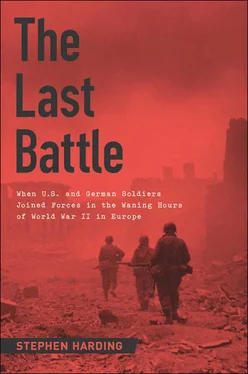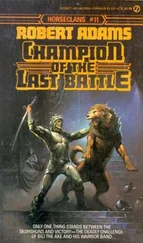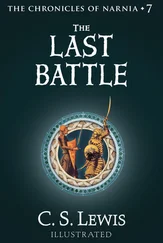22. The date usually observed for the official formation of the Waffen-SS as a distinctly military organization is August 1940.
23. Ibid., 28–29.
24. Ibid., 30.
25. Essentially the German equivalent of the U.S. jeep, the kübelwagen was an inexpensive, four-door convertible-top military utility vehicle designed by Ferdinand Porsche.
26. Ibid., 31.
27. Schrader takes pains to point out that it was a regular passenger train, not a military troop train.
28. Schrader, “Erinnerungen, Gedanken, Erkenntnisse,” 36.
29. Čučković’s reference to “Mühltal” can be confusing, as there are several small villages by that name within twenty miles of Schloss Itter. The Wimmers’ farmhouse was actually in an area now known as Itter-Mühltal, just east of Niederau.
30. This exchange and the account of Čučković’s ride to Innsbruck are drawn from Čučković, “Zwei Jahren auf Schloss Itter,” 51–53.
31. As commander of the 101st Airborne Division when it was encircled by the Germans at Bastogne, Belgium, in December 1944, McAuliffe famously responded to a demand for surrender with a one-word reply: “Nuts!”
32. This man was apparently part of the 103rd Infantry Division’s military-government section; unfortunately, his name is lost to history.
33. Reynaud, In the Thick of the Fight , 654.
34. Schrader, “Erinnerungen, Gedanken, Erkenntnisse,” 36.
35. This incident is recounted in Reynaud, In the Thick of the Fight , 654.
36. Unfortunately, we have no first names for most of the soldiers who chose to join Sepp Gangl in protecting the people of Wörgl.
37. While the vast majority of German military personnel who surrendered to U.S. forces in Europe survived the process, it was certainly not unheard of for GIs to summarily execute prisoners—most notably in the days after the June 1944 Normandy landings and in the wake of the December 1944 Waffen-SS murder of eighty-four American POWs in Malmedy, Belgium, during the Battle of the Bulge. However, the Allied liberation of the Nazis’ concentration, extermination, and slave-labor camps led to a spike in the number of German prisoners—especially Waffen-SS and SS-TV members—killed while attempting to surrender or following surrender. On April 29, 1945, the day Dachau was liberated by elements of the U.S. 42nd and 45th Infantry divisions, between sixteen and approximately fifty of the camp’s SS-TV guards were killed by American troops, many after surrendering.
38. Operations in Germany, 1–10 May 1945 , 68–70.
1. An 1806 graduate of West Point—and its superintendent from 1814 to 1818—Partridge came to believe that the national military academy system exemplified by his alma mater had created and was perpetuating a closed military elite. He strenuously advocated the establishment of state militias led by officers trained in private, regional military colleges. He established seven such institutions himself, with Norwich being the first and ultimately most successful.
2. Indeed, because its founder established the principles of what evolved into the Reserve Officer Training Corps program, Norwich University bills itself as the birthplace of ROTC, though there is some disagreement as to where the first ROTC unit was constituted.
3. Though most Norwich graduates were commissioned into the cavalry branch, such an assignment was not a foregone conclusion. Graduates could request assignment to another branch, or their first branch choice might be turned down by the army if officers were needed in other fields. Of the seventy-nine graduates in Lee’s class of 1942, sixty—including Lee— were assigned to the cavalry, thirteen to the army air forces, and two each to the engineer corps, signal corps, and chemical warfare service.
4. The U.S. War Department’s 1930 establishment of the mechanized force ensured that the horse’s days in army service were numbered. Mounted cavalry units were converted to mechanized organizations as quickly as funding and vehicles could be provided. While military horsemanship was taught in all four years of Lee’s time at Norwich, he and his fellow students also received instruction in the operation and use of armored cars and other military vehicles during their junior and senior years. As it happened, Lee and the other members of his Class of 1942 were the last Norwich cadets to receive horse-cavalry training. In March 1943 the school’s entire corps of cadets was taken directly into military service, and from then until the end of the war Norwich did not accept students, instead acting as an auxiliary training school for army aviation cadets. By the time regular instruction resumed in 1946, the university had disposed of all its horses and officially discontinued cavalry training. From then on Lee and his classmates were referred to as the Horsemen of ’42.
5. The woman’s maiden name remains unclear.
6. Construction had begun in January 1942. The post was renamed Fort Campbell in 1950, and as of this writing remains the home installation of the 101st Airborne Division, the 5th Special Forces Group, and the 160th Special Operations Aviation Regiment.
7. Organizational details for both the 12th AD and 23rd TB are drawn from Ferguson, Hellcats , and Francis, A History of the 23rd Tank Battalion .
8. A coaxial machine gun is mounted inside the tank’s turret, alongside and parallel to the main gun. The machine gun fires in the same direction as the main gun and is used against such “soft” targets as unarmored vehicles and troops in the open.
9. Armored Force Field Manual , 10.
10. “Capt. Jack Lee, ’42, Rescues Daladier in Castle Battle,” Norwich Record (Northfield, VT), June 22, 1945, 5.
11. Basse by all accounts was a very nice man. In a 2012 interview with the author, Calbert Duvall, a driver in Company B’s 2nd Platoon, related an example of Basse’s kindness: while the 23rd was still at Camp Barkley, Duvall’s young wife and infant daughter arrived from upstate New York for a very brief visit. Duvall was supposed to have guard duty, but Basse pulled the eight-hour detail in the young soldier’s place so Duvall could spend the time with his family.
12. Built between 1913 and 1919 by Germany’s Vulcan AG shipyard and originally intended for service with the Hamburg-Amerika Line, the twenty-two-thousand-ton vessel was transferred in 1920 to Britain as part of the war reparations the Allies awarded themselves at the Paris Peace Conference. The ship passed to Canadian Pacific in 1921 and was initially named Empress of China but became Empress of Australia the following year. It reentered transatlantic passenger service after World War II and was scrapped in 1952.
13. Francis, History of the 23rd Tank Battalion , 10–12.
Читать дальше












